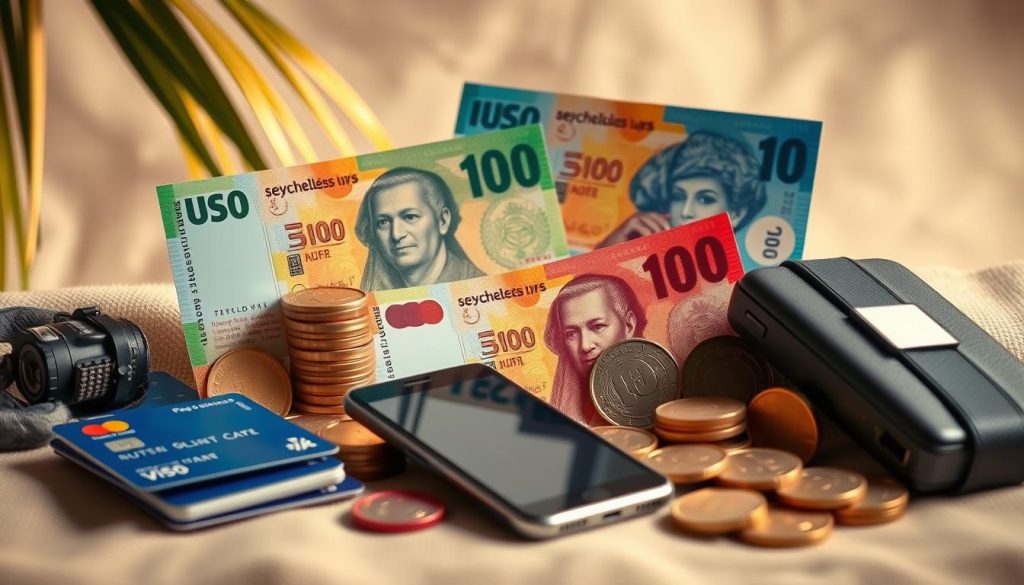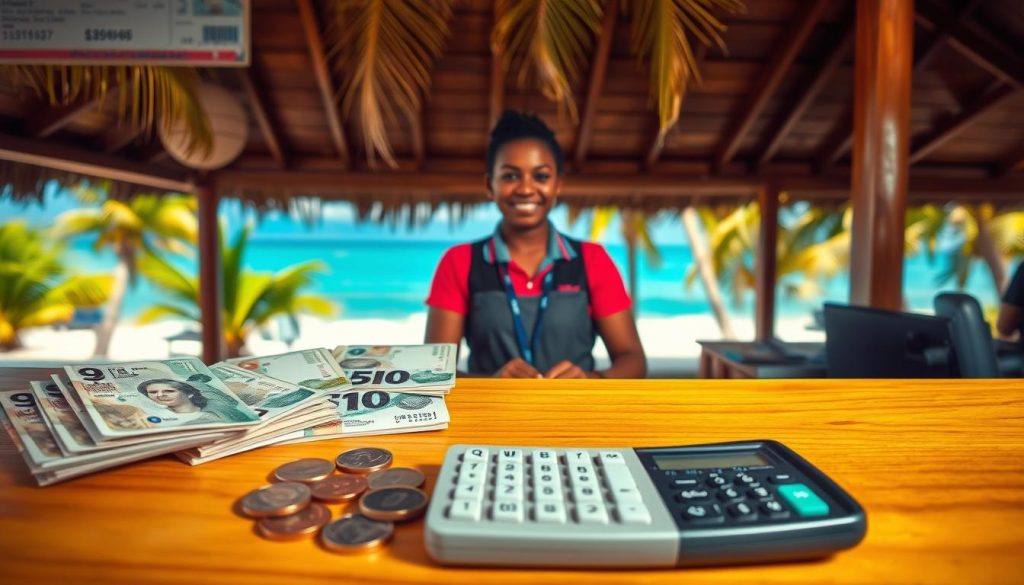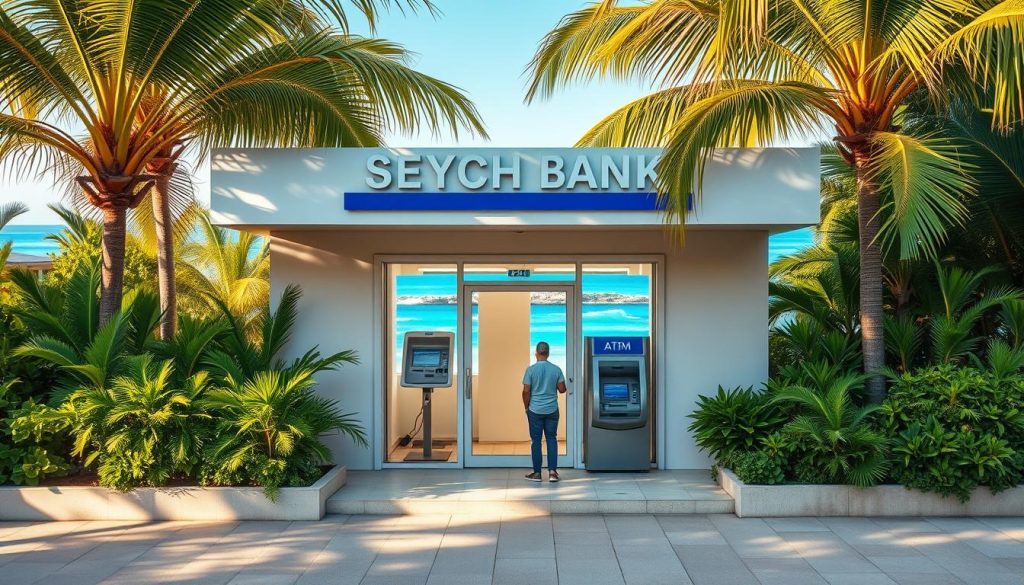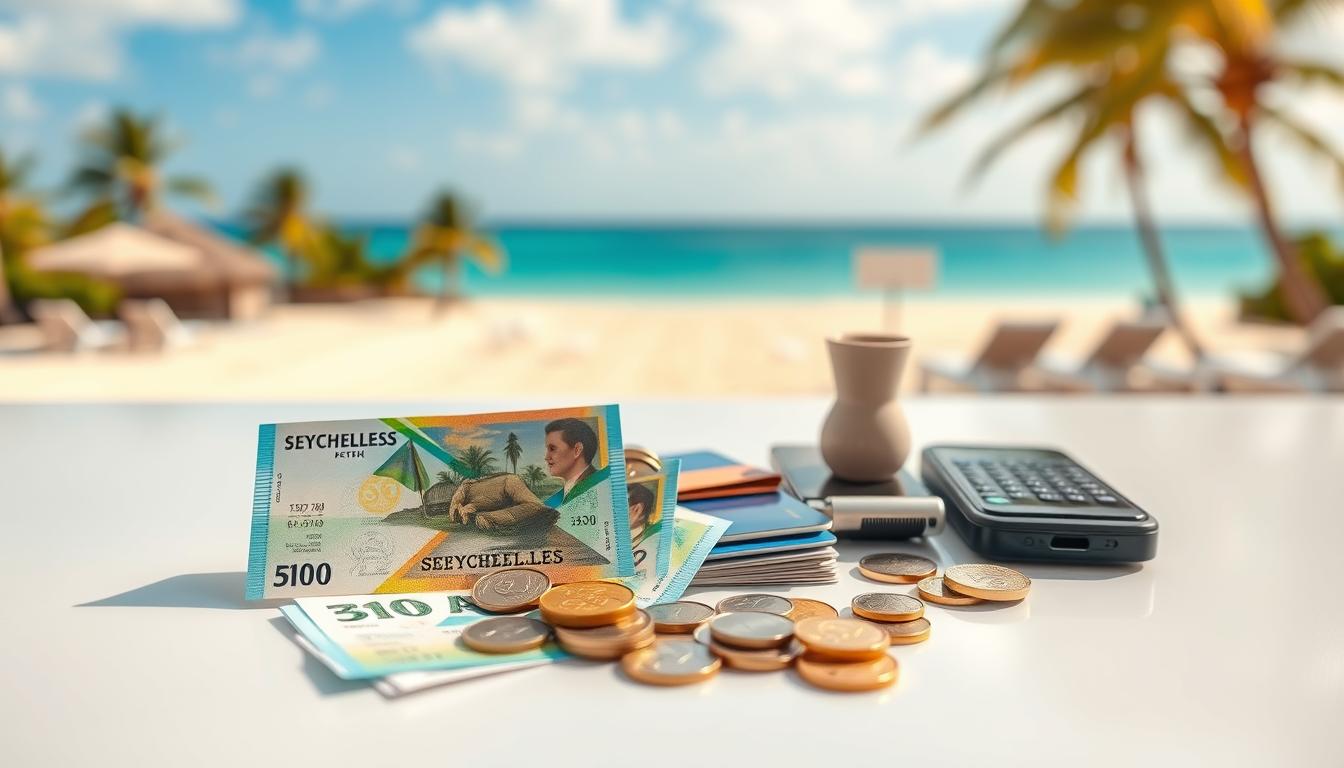✓ Accommodations✓ Flights✓ Rental Cars✓ Tours & Activities
Did you know that understanding currency and payment options can save you hundreds of dollars on your next trip? In fact, travelers who plan ahead often avoid hidden fees and enjoy a smoother experience. If you’re heading to a destination where the local money is the Seychellois Rupee (SCR), knowing the basics can make all the difference.
Using the right card or cash can help you save on exchange rates and avoid unnecessary costs. Whether you’re booking accommodations or dining out, having the correct payment method ensures you’re prepared for any situation. This guide will walk you through everything you need to know about managing your money during your trip.
From understanding the SCR to finding the best ATM options, we’ve got you covered. Let’s dive in and make your travel experience seamless and stress-free!
Introduction to Seychelles Currency Systems and Payment Options
Planning your finances is key to a stress-free trip. The official currency here is the Seychellois Rupee (SCR), which is essential for most transactions. It’s divided into 100 cents, with banknotes in denominations of 10, 25, 50, 100, and 500 rupees. Coins are also available for smaller purchases.
When it comes to payment methods, you have several options. Cash is widely accepted, especially for smaller vendors. Debit and credit cards are also common, with MasterCard and Visa being the most widely accepted. However, always check for foreign transaction fees before using your card.
Comparing exchange rates is crucial. Use mid-market resources or online converters to ensure you get the best deal. Avoid dynamic currency conversion, as it often comes with hidden fees. Instead, opt for travel money cards to save on unnecessary costs.
Preparing in advance can make a big difference. Exchange some money before your trip to avoid high airport rates. Carry a mix of cash and cards for flexibility. This section sets the stage for a deeper dive into managing your money effectively during your stay.
Seychelles: Ultimate Travelers Guide to Currencies & Payments
Managing your finances smartly can make your trip smoother and more enjoyable. Understanding the local payment systems and exchange rates ensures you’re always prepared for any situation. This guide focuses on helping you navigate these essentials with ease.
One of the first things to consider is how to handle your money. The local currency, the Seychellois Rupee (SCR), is widely used for most transactions. However, having a mix of cash and cards provides flexibility. For example, debit cards and credit cards are accepted in many places, but it’s wise to check for foreign transaction fees before using them.

Travel cards, like those from Wise, are a great low-cost option. They allow you to manage multiple currencies in one account, making it easier to avoid unnecessary fees. Always compare exchange rates to get the best deal. Mid-market rates are often the most favorable.
Here’s a quick comparison of payment options:
| Option | Pros | Cons |
|---|---|---|
| Cash | Widely accepted, no fees | Risk of loss or theft |
| Debit Card | Convenient, secure | Foreign transaction fees |
| Travel Card | Low fees, multi-currency | Initial setup required |
Finally, always plan in advance. Exchange some money before your trip to avoid high airport rates. Carry a mix of cash and cards for flexibility. By following these tips, you’ll save time, reduce stress, and make the most of your travel budget.
Preparing Your Travel Budget for Seychelles
A well-planned budget ensures you get the most out of your travel experience. Understanding trip costs and daily outgoings is essential for effective planning. By estimating expenses in advance, you can avoid overspending and enjoy your journey worry-free.
Understanding Trip Costs and Daily Outgoings
Daily expenses can vary depending on your travel style. For budget travelers, the average daily cost is around $137, while mid-range travelers spend about $313. Luxury travelers may spend up to $592 per day. These costs include accommodation, meals, transportation, and entertainment.
Accommodation is one of the biggest expenses. Budget options start at $55 per night, while mid-range hotels cost around $128. Luxury stays can go up to $240 per night. Meals also vary, with budget meals averaging $35 per day and luxury dining costing $150.
Budgeting for Accommodation, Meals, and Activities
To create an effective budget, break down your expenses into categories. Here’s a quick overview of average costs:
| Category | Budget | Mid-Range | Luxury |
|---|---|---|---|
| Accommodation | $55 | $128 | $240 |
| Meals | $35 | $79 | $150 |
| Activities | $60 | $100 | $200 |
Track your spending using apps or a simple spreadsheet. This helps you adjust your budget as needed. Choose payment methods wisely to avoid extra fees. Travel cards like Wise can save you money on foreign transactions and ATM withdrawals.
Finally, compare prices and exchange rates to get the best deal. Planning in advance ensures you’re prepared for any situation. With a well-structured budget, you can focus on enjoying your trip without financial stress.
Currency Exchange Essentials in Seychelles
Getting the best exchange rate can save you money and make your trip more enjoyable. Understanding how to track the mid-market USD/SCR rate and knowing where to exchange your currency are key to avoiding unnecessary fees.

How to Track the Mid-Market USD/SCR Rate
The mid-market rate is the real exchange rate between two currencies, without added fees. It’s the rate banks use when trading with each other. To get the best deal, always check this rate before exchanging your money.
Use tools like XE, OANDA, or Wise to track live exchange rates. These platforms provide up-to-date data, helping you make informed decisions. Avoid dynamic currency conversion, as it often includes hidden fees.
When and Where to Exchange Money
Timing is crucial when exchanging currency. Rates fluctuate daily, so monitor them in advance to identify the best time to convert your money. Exchanging at airports or hotels is convenient but often comes with high fees.
Instead, visit local banks or authorized exchange offices in city centers. They typically offer better rates. Travel cards, like those from Wise, are another low-cost option. They allow you to manage multiple currencies in one account, saving you on foreign transaction fees.
“Always compare rates from multiple providers to ensure you’re getting the best deal.”
Here are some quick tips for hassle-free currency exchange:
- Track the mid-market rate using reliable tools.
- Avoid exchanging money at airports or hotels.
- Use travel cards for low-cost transactions.
- Compare rates at local banks or exchange offices.
By following these practices, you’ll save money and enjoy a smoother travel experience. Planning ahead ensures you’re always prepared, no matter where your journey takes you.
Best Payment Methods in Seychelles: Cash, Debit, and Credit
Choosing the right payment method can make your trip hassle-free. Whether you’re shopping, dining, or exploring, knowing your options ensures you’re always prepared. Let’s compare the primary ways to pay and their pros and cons.
Cash is widely accepted, especially for small transactions like tipping or buying from local vendors. It’s a reliable option since it doesn’t incur foreign transaction fees. However, carrying too much cash can be risky, so it’s best to keep only what you need for the day.
Debit cards are convenient for withdrawing local currency from ATMs. They’re secure and widely accepted, but be aware of withdrawal fees and foreign transaction fees. Always check with your bank before your trip to avoid surprises.
Credit cards are great for larger purchases and offer added security. Many merchants accept Visa and MasterCard, but American Express may not be as widely used. Be cautious of foreign transaction fees, which can add up quickly.
Travel cards, like those from Wise, are a smart alternative. They allow you to manage multiple currencies in one account, saving you on fees. Plus, they’re easy to reload and use wherever you go.
Here’s a quick comparison of the main payment methods:
| Method | Pros | Cons |
|---|---|---|
| Cash | No fees, widely accepted | Risk of loss or theft |
| Debit Card | Secure, easy ATM access | Withdrawal and foreign fees |
| Credit Card | Convenient, secure | Foreign transaction fees |
To stay flexible, carry a mix of cash and cards. This ensures you’re prepared for any situation, whether you’re at a market or a high-end restaurant. Always keep your funds secure by using a money belt or hotel safe.
Finally, choose reputable providers for your travel cards to avoid extra charges. Planning in advance saves you time and money, making your trip smoother and more enjoyable.
How to Avoid Currency Conversion and Transaction Fees
Saving on fees while traveling is easier than you think. By understanding how to navigate currency conversion and transaction fees, you can keep more money in your pocket. Let’s explore practical strategies to avoid unnecessary charges.

Avoiding Dynamic Currency Conversion
Dynamic currency conversion (DCC) occurs when a merchant offers to charge you in your home currency instead of the local one. While it may seem convenient, it often comes with higher exchange rates and hidden fees. Always opt to pay in the local currency, like the SCR, to avoid these extra costs.
Here’s how to decline DCC:
- Ask the merchant to charge you in the local currency.
- Double-check your receipt to ensure the charge is in SCR.
- Use a travel card or credit card that doesn’t apply foreign transaction fees.
Tips for Steering Clear of Airport Currency Markups
Exchanging money at airports is convenient but often expensive. Airport kiosks typically charge higher rates and additional fees. Instead, plan ahead and exchange a small amount before your trip. Use local banks or authorized exchange offices for better rates.
Other ways to avoid airport markups:
- Withdraw local currency from ATMs in the city.
- Use a low-cost travel card to manage multiple currencies.
- Compare exchange rates online before your trip.
Finally, always check your debit or credit card terms for foreign transaction fees. Some cards offer low-cost or fee-free options for international use. By following these tips, you’ll save money and enjoy a smoother travel experience.
Travel Cards and International Debit Options
Travel cards are a game-changer for managing your money abroad. They offer convenience, security, and low-cost solutions for handling multiple currencies. Whether you’re withdrawing cash or making purchases, these cards simplify your financial transactions.
One of the most popular options is the Wise Multi-Currency Card. It supports over 40 currencies and uses the mid-market exchange rate, saving you on unnecessary fees. With features like free ATM withdrawals up to $6,000 per month, it’s a top choice for frequent travelers.
Wise Multi-Currency Card Features
The Wise card allows you to hold and spend in multiple currencies without incurring foreign transaction fees. Its mobile app makes it easy to manage your account, track spending, and convert currencies at the best rate. Plus, it’s accepted worldwide, making it a versatile option for any destination.
Security is another key benefit. Since the card is separate from your primary bank account, it minimizes risk if lost or stolen. You can also freeze the card instantly via the app, adding an extra layer of protection.
Comparing Revolut and Other Providers
Revolut is another strong contender in the travel card market. It offers multi-currency support, competitive exchange rates, and a user-friendly app. However, it has a monthly withdrawal limit of $500, which may not suit all travelers.
Here’s a quick comparison of Wise and Revolut:
| Feature | Wise | Revolut |
|---|---|---|
| Currencies Supported | 40+ | 30+ |
| ATM Withdrawal Limit | $6,000/month | $500/month |
| Foreign Transaction Fee | None | None |
| App Functionality | Advanced | User-Friendly |
Both cards are excellent choices, but your decision may depend on your travel needs. If you require higher withdrawal limits and more currency options, Wise might be the better fit. For those prioritizing low-cost transactions and ease of use, Revolut is a solid option.
By choosing the right travel card, you can save on fees, manage your money efficiently, and enjoy a stress-free trip. Always compare features and fees in advance to find the best card for your journey.
Tips for Withdrawing and Managing Cash in Seychelles
Handling cash wisely can make your trip smoother and more secure. Knowing where to find ATMs and how to minimize fees ensures you’re always prepared. Here’s a detailed guide to help you manage your money effectively.

Finding ATMs and Safe Withdrawal Practices
ATMs are widely available in most towns and cities. Look for machines located in secure areas like banks or shopping centers. Avoid standalone ATMs in remote locations, as they may pose a higher risk of skimming devices.
To minimize fees, use a debit card that offers low or no international withdrawal charges. Always decline dynamic currency conversion to avoid poor exchange rates. Instead, opt to withdraw in the local currency, SCR.
Using Travel Cards and Backup Cash
A travel card like the Wise Multi-Currency Card is a great option. It allows you to manage multiple currencies in one account and offers low fees for ATM withdrawals. Keep a small amount of backup cash for emergencies, especially in areas where ATMs are scarce.
Safe Handling and Storage of Cash
Carry only the cash you need for the day and store the rest in a secure place, like a hotel safe. Use a money belt or hidden pouch to keep your money safe while exploring. Avoid displaying large amounts of cash in public.
Tracking Exchange Rates and Fees
Use apps like XE or Wise to track exchange rates in real-time. This helps you identify the best time to withdraw cash. Always check your account statements to monitor transaction fees and ensure there are no unauthorized charges.
Budgeting Daily Cash Needs
Plan your daily cash needs based on your activities. For example, allocate cash for meals, transportation, and tips. Use a budgeting app to track your spending and adjust as needed. This helps you avoid running out of cash unexpectedly.
Managing Your Account via Mobile Apps
Most travel cards come with mobile apps that allow you to manage your account on the go. Use these apps to check your balance, convert currencies, and freeze your card if lost or stolen. This adds an extra layer of security to your money management.
By following these tips, you’ll handle your cash efficiently and enjoy a stress-free trip. Planning in advance ensures you’re always prepared, no matter where your journey takes you.
Comparing Payment Options: Seychellois Rupee vs. US Dollar Usage
Understanding the differences between local and foreign currency usage can save you time and money during your trip. In most cases, the Seychellois Rupee (SCR) is the preferred currency for transactions. While some places accept US Dollars (USD), using SCR often avoids extra fees and ensures smoother payments.
Using USD in place of SCR can lead to higher costs. Many merchants apply unfavorable exchange rates when accepting foreign currency. Additionally, paying with USD may incur foreign transaction fees on your credit card or debit card. These fees can add up quickly, increasing your overall expenses.
| Option | Pros | Cons |
|---|---|---|
| Seychellois Rupee (SCR) | No extra fees, widely accepted | Requires exchange from USD |
| US Dollar (USD) | Convenient for some transactions | Higher costs due to poor rates |
Travel cards, like the Wise Multi-Currency Card, are a low-cost solution. They allow you to hold and spend in multiple currencies, including SCR. This avoids the need for frequent exchange and reduces transaction fees.
When choosing between cash and card, consider the situation. For smaller purchases, cash in SCR is often the best option. For larger expenses, using a credit card or debit card can be more secure. Always check for foreign transaction fees before using your card.
To stay updated on exchange rates, use mobile apps like XE or Wise. These tools provide real-time data, helping you make informed decisions. By planning in advance, you can save money and enjoy a hassle-free trip.
Smart Payment Solutions and Mobile Apps for Travel
Staying on top of your finances while traveling has never been easier with today’s smart payment solutions. From mobile apps to travel cards, managing your money abroad is now seamless and secure. These tools not only simplify transactions but also help you avoid unnecessary fees.
Mobile apps are a game-changer for travelers. They allow you to manage multiple currencies, track exchange rates in real-time, and monitor your spending. Apps like Wise and Revolut offer features such as instant notifications and budgeting tools, making it easy to stay in control of your account.
Travel cards are another low-cost option. Cards like the Wise Multi-Currency Card let you hold and spend in over 40 currencies without incurring foreign transaction fees. They’re accepted worldwide and come with mobile apps for easy management. This makes them a versatile choice for any trip.
Here’s a quick comparison of popular travel money apps:
| Feature | Wise | Revolut |
|---|---|---|
| Currencies Supported | 40+ | 30+ |
| ATM Withdrawal Limit | $6,000/month | $500/month |
| Foreign Transaction Fee | None | None |
| App Functionality | Advanced | User-Friendly |
To maximize security, set up transaction alerts on your phone. This ensures you’re notified of every payment or withdrawal. Additionally, use apps to freeze your card instantly if it’s lost or stolen. These features add an extra layer of protection to your travel money.
Finally, always compare exchange rates and fees before making transactions. Apps like XE and OANDA provide real-time data, helping you make informed decisions. By planning in advance, you can save money and enjoy a hassle-free trip.
With the right tools, managing your finances abroad is simple and stress-free. Whether you prefer a travel card or a mobile app, these solutions ensure you’re always prepared.
Conclusion
Smart financial planning can transform your travel experience. Understanding local payment systems and avoiding unnecessary fees ensures you make the most of your trip. Whether you use cash, a debit card, or a travel card, having the right option saves you time and money.
Tools like the Wise Multi-Currency Card simplify managing multiple currencies and offer low-cost solutions. Always track exchange rates and plan in advance to avoid hidden charges. A mix of payment methods provides flexibility and security, whether you’re dining out or exploring local markets.
By staying informed and using smart payment solutions, you can reduce overall costs and enjoy a hassle-free journey. Use this guide as a reference to manage your account and expenses effectively. With the right preparation, you’ll travel with confidence and peace of mind.
The above is subject to change.
Check back often to TRAVEL.COM for the latest travel tips and deals.






